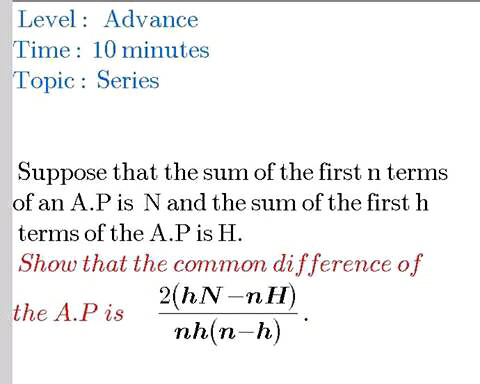Question Number 9752 by tawakalitu last updated on 30/Dec/16

Answered by mrW last updated on 31/Dec/16
![let a_1 be the first term and d the common difference of the A.P. N=(([2a_1 +(n−1)d]×n)/2) ⇒2a_1 +(n−1)d=((2N)/n) ...(i) H=(([2a_1 +(h−1)d]×h)/2) ⇒2a_1 +(h−1)d=((2H)/h) ...(ii) (i)−(ii): (n−h)d=((2N)/n)−((2H)/h)=((2(hN−nH))/(nh)) d=((2(hN−nH))/(nh(n−h)))](https://www.tinkutara.com/question/Q9757.png)
$$\mathrm{let}\:\mathrm{a}_{\mathrm{1}} \:\mathrm{be}\:\mathrm{the}\:\mathrm{first}\:\mathrm{term}\:\mathrm{and} \\ $$$$\mathrm{d}\:\mathrm{the}\:\mathrm{common}\:\mathrm{difference}\:\mathrm{of}\:\mathrm{the}\:\mathrm{A}.\mathrm{P}. \\ $$$$ \\ $$$$\mathrm{N}=\frac{\left[\mathrm{2a}_{\mathrm{1}} +\left(\mathrm{n}−\mathrm{1}\right)\mathrm{d}\right]×\mathrm{n}}{\mathrm{2}} \\ $$$$\Rightarrow\mathrm{2a}_{\mathrm{1}} +\left(\mathrm{n}−\mathrm{1}\right)\mathrm{d}=\frac{\mathrm{2N}}{\mathrm{n}}\:\:\:\:\:…\left(\mathrm{i}\right) \\ $$$$\mathrm{H}=\frac{\left[\mathrm{2a}_{\mathrm{1}} +\left(\mathrm{h}−\mathrm{1}\right)\mathrm{d}\right]×\mathrm{h}}{\mathrm{2}} \\ $$$$\Rightarrow\mathrm{2a}_{\mathrm{1}} +\left(\mathrm{h}−\mathrm{1}\right)\mathrm{d}=\frac{\mathrm{2H}}{\mathrm{h}}\:\:\:\:\:…\left(\mathrm{ii}\right) \\ $$$$\left(\mathrm{i}\right)−\left(\mathrm{ii}\right): \\ $$$$\left(\mathrm{n}−\mathrm{h}\right)\mathrm{d}=\frac{\mathrm{2N}}{\mathrm{n}}−\frac{\mathrm{2H}}{\mathrm{h}}=\frac{\mathrm{2}\left(\mathrm{hN}−\mathrm{nH}\right)}{\mathrm{nh}} \\ $$$$\mathrm{d}=\frac{\mathrm{2}\left(\mathrm{hN}−\mathrm{nH}\right)}{\mathrm{nh}\left(\mathrm{n}−\mathrm{h}\right)} \\ $$
Commented by tawakalitu last updated on 31/Dec/16

$$\mathrm{God}\:\mathrm{bless}\:\mathrm{you}\:\mathrm{sir}.\:\mathrm{I}\:\mathrm{appreciate}. \\ $$
